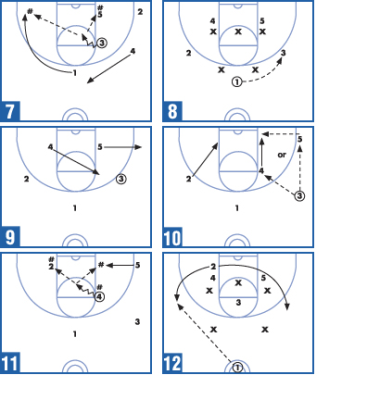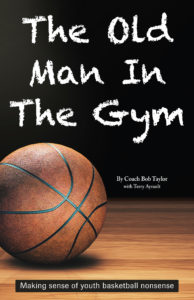Attacking the Syracuse 2-3 match-up zone
Watching Jim Boeheim’s Syracuse University teams roll over the years did little to ease fears in the coaching community regarding the 2-3 match-up zone.
Studying this defense, coaching many variations of the match-up zone, and by watching teams attempt to attack it in the Big East has allowed us to design several proven techniques to successfully attack it.

The Syracuse 2-3 match-up zone differs from other zones and match-ups. The forwards sometimes come to cover the first pass and always cover all three guard-reversal passes until the guard gets there to “bump” the coverage. The guards don’t cover the high post, which allows them to extend into the passing lanes in the same way as they would in a 1-3-1 zone. They are also very aggressive at forcing and then trapping the dribble.
Our goal, regardless of the set, is to get the ball into the high post and rotate high-low by dropping whichever high-post player didn’t get the ball. We also flare a shooter from the wing to the corner. This high-to-low weak- or strong-side drop essentially backdoors the forward on the reversal of the ball, while the center is forced to adjust to two high-post players instead of one. We call this position the “open-side high post.”
You must teach your players to attack from this open-side high-post position. They should attack the middle player and read the options. A bounce pass off shot fakes can be effective in the lane, but only if you teach your low players to seal the dropping forwards.
If your players are unable to attack from this position, or if your perimeter ball handler can’t enter the ball into the high post, your team will struggle offensively.
Don’t psych your players out by acting overly worried or nervous about facing a 2-3 match-up. Avoid communicating a fear or concern that this defense can’t be exploited.
‘Foul-line set’ attack
On the first pass, the two post players (who are stationed at the elbows) rotate into a “high-to-low weak-side drop” so that there is one post player on the strong-side high post, and one on the strong-side low post.
DIAGRAM 1: Initial entry movements. 1 makes an entry pass to 3 on the wing. While the pass is made, 4 drops from the weak-side high post to the strong-side low post.
This formation could also be accomplished by using what’s called an “L-rotation” high-to-low, where 5 would drop straight down to the low-post area and 4 would slide over to the strong-side high-post area.
DIAGRAM 2: Weak-side elbow pass. As 3 kicks the ball out to the top, 4 pops up diagonally across the lane to the weak-side elbow. As 4 breaks up, 5 drops straight down to the low post while 2 flares to the weak-side corner. 1 hits 4 at the weak-side elbow.

4 looks to immediately kick the ball to 2 in the corner for a jump shot from the elbow or drive to the basket.
DIAGRAM 3: Strong-side elbow pass. On this option, 3 passes out to 1 on top and 1 quickly passes to 5 at the strong-side elbow. On the pass to 5, 4 automatically drops to the weak-side low block, and 3 flares to the strong-side corner.
5 can lob the ball into 4 on the weak-side low-post pass to 3 in the corner, shoot a short jumper from the elbow or drive to the basket.
Diamond attack L-flash
From this set, 2 sets up in the low post behind the zone.
DIAGRAM 4: Diamond attack (entry). 1 draws the top two defenders and passes to 4 on the wing.
DIAGRAM 5: Diamond attack (L-flash). On the pass to 4, 2 breaks to the strong-side corner, 5 drops to the strong-side low post, and 3 slides over from the weak-side wing to the strong-side elbow.
DIAGRAM 6: Diamond attack (read the defense). 4 must read the defense and decide if he or she will throw the ball in to 3 at the elbow, or swing a pass to 1 out top.
DIAGRAM 7: Diamond Attack (From Strong-Side Elbow). If the pass goes to 3 at the strong-side elbow, 1 must flare to the weak-side corner. 4 replaces 1 at the top.
If 5 can seal the forward on his or her side, a shot fake in the lane by 3 and bounce pass to 5 can be effective.
Overload attack

In this set, 4 and 5 line up behind the zone in the low post.
DIAGRAM 8: Overload attack (entry). 1 draws the top two defenders and passes to 3 on the right wing.
DIAGRAM 9: Overload attack (post flash to ball). 4 cuts toward the ball by making a diagonal cut through the lane from the weak-side low post to the strong-side elbow. 5 flashes to the strong-side corner.
DIAGRAM 10: Overload attack (mirror-the-ball concept). If 3 passes to 4 at the elbow, 5 flashes to the basket looking for a pass from 4. If 3 passes to 5 in the corner, 4 drops to the low-post looking for a pass from 5. This is called the “mirror-the-ball” concept. 2 slashes to the basket from the weak-side wing.
DIAGRAM 11: Overload attack (drive and dish). If 4 gets the pass at the elbow, he or she should dribble-drive into the lane and look to make a pass to 2 on the weak-side low post, or to 5 slashing to the basket along the baseline.
Triple-post set attack
In this set, you have three players set up in the low post.
DIAGRAM 12: Triple-post attack (entry). 2 reads the zone and breaks up to the wing area on either side (in this diagram to the left). 1 passes to 2.

DIAGRAM 13: Triple-post attack (corner overload). 3 cuts to the strong-side corner and creates an overload on the strong side. 5 flashes from the low post to the foul line, replacing 3.
DIAGRAM 14: Triple-post attack (corner high-low pass). 2 passes to 3 in the corner. As the defenders slide over, 3 should try to pass to 4 in the low post.
DIAGRAM 15: Triple-post attack (option). If 2 doesn’t pass to 3 in the corner, he or she can kick the ball out to 1 on top. If this happens, 4 flashes to the opposite elbow, and 3 breaks along the baseline to the weak-side corner. 1 passes to 5 or 4.
DIAGRAM 16: Triple-post attack (open-side high-low, left elbow entry). On the entry pass to 5 on the left elbow, 4 drops to the weak-side low post. 5 can either shoot a jump shot, drive to the basket, hit 2 in the corner, or pass to 4 in the low post.












